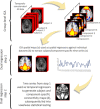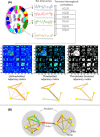Resting-state functional brain networks in Parkinson's disease
- PMID: 26224057
- PMCID: PMC6093256
- DOI: 10.1111/cns.12417
Resting-state functional brain networks in Parkinson's disease
Abstract
The network approach is increasingly being applied to the investigation of normal brain function and its impairment. In the present review, we introduce the main methodological approaches employed for the analysis of resting-state neuroimaging data in Parkinson's disease studies. We then summarize the results of recent studies that used a functional network perspective to evaluate the changes underlying different manifestations of Parkinson's disease, with an emphasis on its cognitive symptoms. Despite the variability reported by many studies, these methods show promise as tools for shedding light on the pathophysiological substrates of different aspects of Parkinson's disease, as well as for differential diagnosis, treatment monitoring and establishment of imaging biomarkers for more severe clinical outcomes.
Keywords: Functional magnetic resonance imaging; Neural networks; Parkinson's disease; Resting-state.
© 2015 John Wiley & Sons Ltd.
Conflict of interest statement
The authors declare no conflict of interests.
Figures



References
Publication types
MeSH terms
LinkOut - more resources
Full Text Sources
Other Literature Sources
Medical

